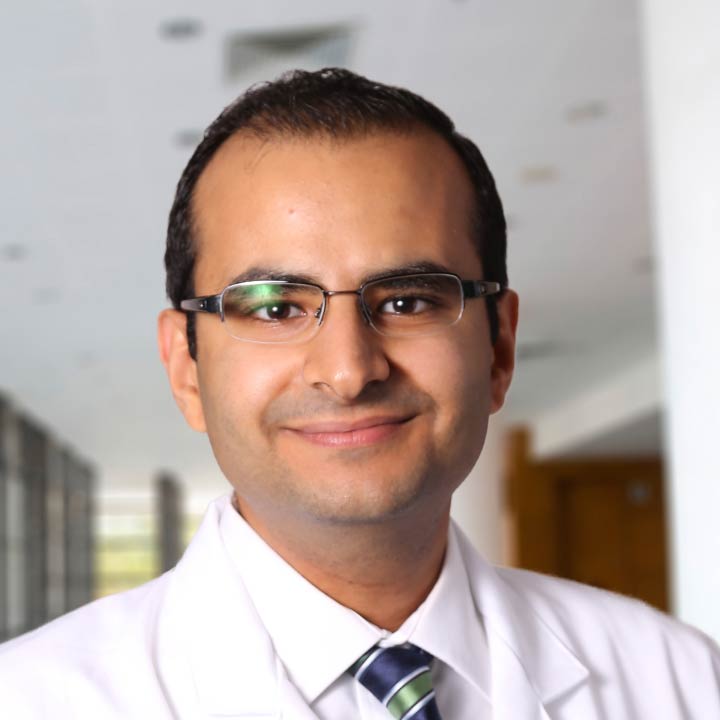Interventional radiology: Cutting-edge, minimally invasive methods treat wide range of diseases

Interventional radiology is a largely unknown specialty of medicine that can offer patients innovative, minimally invasive and often life-changing treatment.
Recognized as its own medical specialty in 2012, interventional radiology is rapidly evolving. Its treatments are already allowing us to cure some cancers, resolve troublesome uterine fibroids, stem bleeding in critical trauma patients, and rebuild veins — all through incisions not much larger than pinholes.
Interventional radiology is key to the future of medicine, and its applications are limitless as technology advances and more physicians adopt this method of care.
What’s interventional radiology?
Interventional radiology procedures often involve making one or more small incisions (usually in your abdomen or groin) and using tiny devices, such as small catheters (thin hollow tubes), wires, beads, balloons and whole host of cutting-edge devices and medicines, to treat disease in blood vessels and organs.
We use radiological imaging, such as X-ray, ultrasound and computerized tomography (CT) to see inside the body and guide our treatments, without needing to make large incisions and open up the body like traditional surgery.
It’s called “interventional” radiology because, while we use radiological imaging to look inside the body and make diagnoses, we can also “intervene” and treat conditions if necessary. Interventional radiologists are specialized and broadly trained physicians who meet with patients in clinic and hospital settings, and they perform a wide range of outpatient and inpatient procedures.
What are the benefits of interventional radiology approaches compared with traditional surgery?
Interventional radiology approaches can be better than open, invasive surgical treatments, depending on the situation and the patient. When it’s the better option, advantages include:
- Less invasive procedures
- Quicker recovery times
- Less risk of complications
- Often better outcomes
- Opening treatment and giving new treatment options to patients without alternatives
- Cost-effectiveness
In many situations, interventional radiology provides all the positives that we want in medicine. In addition to treating acute disease in critical patients, we also handle elective procedures that improve quality of life, and we give hope to people who otherwise have no options.
How is interventional radiology used to cure and treat cancer patients?
Certain cancer tumors in the liver, kidney and lungs can be cured through ablation. This involves placing a small probe or rod-like device through the skin and into the organ to heat or freeze the tumor.
This is 90% effective in killing small tumors in real time. Patients could go home the same day, cancer-free with a pinhole incision and a small bandage.
Other liver cancer treatments involve entering the liver through an artery using a wire and small catheter placed in the groin area. We target the blood supply to the liver tumor, blocking it with small beads in an effort to shrink or control-kill it. Depending on the type of cancer, these particles may be coated with radiation or chemotherapy targeted for the tumor.
We also can treat symptoms in cancer patients, maintaining or improving quality of life, by helping alleviate tumor blockages, place drains in kidneys or treat nerves to reduce pain.
Because interventional radiologists are also trained in diagnostic radiology, they often are involved in imaging, biopsy and diagnosing stages for cancer patients. They also may place ports in patients’ chests to allow for the delivery of chemotherapy drugs.
What other conditions are treated through interventional radiology?
Ohio State is unique because we offer high-level intermediate radiology procedures not available everywhere. We treat a broad range of conditions. Some examples:
- For life-threatening internal bleeding from surgery, tumors, or traumas such as car crashes, we can block off the source of the blood flow using a variety of treatment agents.
- For internal pockets of infection and abscesses, we can place drains to get rid of the infection.
- For kidney or liver obstructions, we can place tubes, stents and drains for relief.
- For benign tumors causing pressure and pain, we can try to shrink them by cutting off blood flow.
- For uterine fibroids, we can place tiny particles in blood vessels to stop the fluid flow, allowing the fibroids to shrink naturally while preserving the uterus.
- For prostate enlargement, we can do the same thing, placing particles in vessels without risk of bleeding or sexual dysfunction.
- For vessels blocked by blood clots or tumors, we can open them or rebuild them using prosthetic grafts and stents.
What types of tools are used in interventional radiology?
It depends on the procedure. Sometimes we use X-ray guidance, sometimes we use scans and sometimes we use ultrasounds. We make tiny incisions and put small wires or tubes, kind of like very small straws, into a blood vessel. We put equipment and medicine through those wires to treat blood vessels or organs.
Some examples of other equipment we use:
- Stents, which are similar to small pipes
- Balloons to open veins or arteries
- Materials to block bleeding vessels
- Beads to treat disease
- Drains for infection
Do interventional radiology procedures require anesthesia?
General anesthesia is sometimes used during interventional radiology procedures, but often we use only moderate sedation or even just local anesthetics. For example, during a uterine fibroid embolization, you might be in a “twilight” situation — comfortable, but awake enough to breathe on your own and respond to your physician. We also place local numbing agents to control pain where we make incisions to inject instruments.
Are there concerns about radiation exposure with interventional radiology procedures?
Radiation exposure is minimal. Getting a CT scan exposes you to the same amount of radiation as taking a flight from New York to Los Angeles, and our procedures tend to use much less radiation.

When you give to The Ohio State University Wexner Medical Center, you’re helping improve lives
We’re committed to making advancements in research, education and patient care that will have an impact throughout Ohio and the world.
Ways to Give




